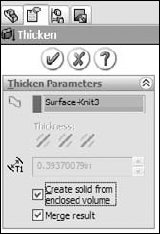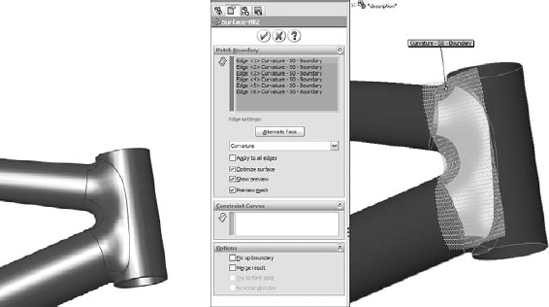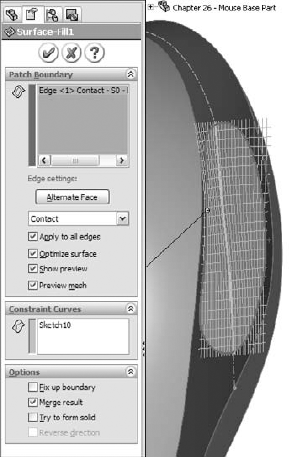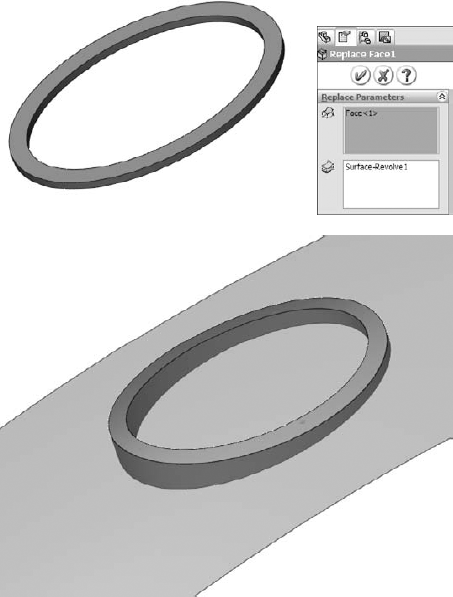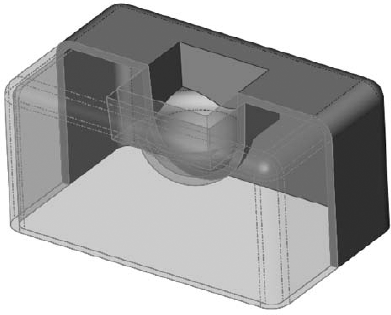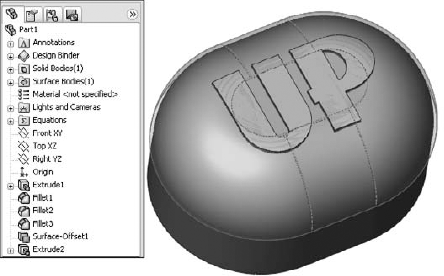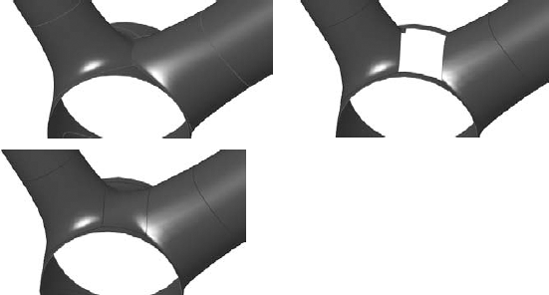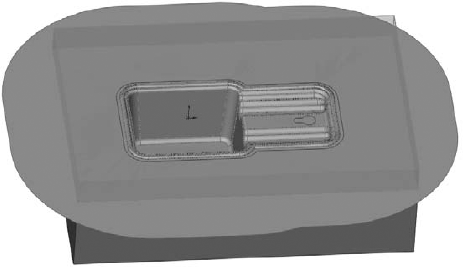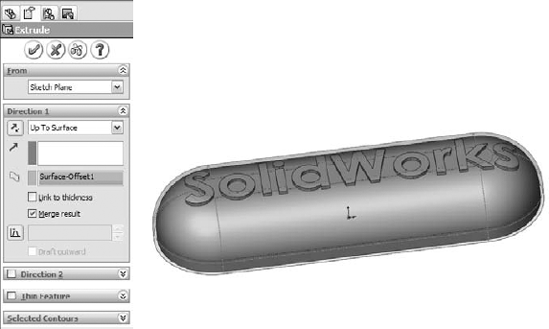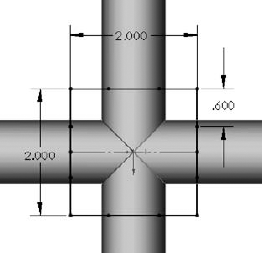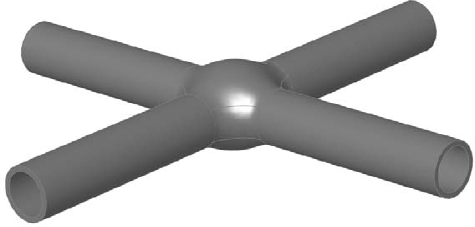IN THIS CHAPTER
Why do you need surfaces?
Understanding surfacing terminology
What surface tools are available?
Using surfacing techniques
Tutorial: Working with surfaces
From a CAD point of view, a solid is defined as the volume enclosed by a surface boundary. To enclose a volume, the boundary must have no gaps or overlaps. The skin or surface of the boundary itself is infinitely thin, and has no volume, although it has a surface area. In this way, surfaces are one of the building blocks of solids.
In many respects, there are no real differences between a solid model and a surface model. If you export a SolidWorks part to IGES format and read it into another capable modeler, or even back into SolidWorks, then that file can be read in as either a solid or a surface. There is no way to distinguish which it was when it left the originating modeler. The real difference between the two is how the modeler handles the data internally.
It is possible to drive a car without knowing how the engine works, but you cannot get the most possible power out of the car by only pressing harder on the gas pedal; you have to get under the hood and make adjustments. In a way, that is what working with surfaces is really all about.
Surface modeling can start from a blank screen, from imported geometry, from native SolidWorks solid and surface features that have been built side by side, or from a native or imported solid that has been deconstructed into surfaces.
The goal of most surface modeling is to finish with a solid. In the same way in which we learned to refer to solids as "solid bodies," surface features can also be knitted together into a single contiguous body. This does not happen by default, however. By default, solid features are automatically merged into a single body if they touch one another and can form a single body. Surface features do not do this automatically; in fact, most surface features do not even have the option to be knitted (the surface equivalent of the solid "merge") together, but require an additional Knit feature to do this.
In the end, you may never really need surfaces. It is possible to perform workarounds using solids to do most of the things that most users need to do. However, many of these workarounds are very inefficient and cumbersome. Although you may not look at some typical things that you now do as being inefficient and cumbersome, once you see the alternatives, you may change your mind. The goal for this chapter is to introduce surfacing functions to people who do not typically use surfaces, and for everyday modeling. Here I am not trying to show how surfaces are used in the context of creating complex shapes, although the same techniques can be used, regardless of the complexity of the shape.
The word surfacing has often been used (and confused) synonymously with the creation of complex shapes. Not all surface work is done to create complex shapes, and many complex shapes can be made directly from solids. Many users think that because they do not make complex shapes, they never need to use surface features. This chapter shows mainly examples that are not complex shapes, in situations where surfaces make it easier, more efficient, or simply possible to do the necessary tasks.
While some of the uses of surfaces may not be immediately obvious, by the end of this chapter, you should have enough information and applications that you can start experimenting to increase your confidence.
When dealing with surfaces, different terminology may often be used that is not typically used with solid modeling. It is important to understand the terminology, which makes the techniques easier to understand. This special terminology also often exists for surfaces because of important conceptual differences between how solids and surfaces are handled.
These terms are fairly universal among all surfacing software. The concepts underlying surface and solid construction are generally uniform between the major software packages. What varies from software to software is how the user interacts with the geometry through the software interface. You may never see some of these terms in the SolidWorks menus, Help files, training books, or elsewhere, but it becomes obvious as you use the software that the concepts are relevant.
Knit is also sometimes used in the same way that the zero-distance offset is used, to copy a set of solid faces to become a new surface body.
One nice option that enables you to quickly see where the boundaries of a surface body lie is found at Tools
Untrim works on native and imported geometry. It is not truly like feature history in imported geometry, but it does help to uncover the underlying original shape of the face.
Modeling software has long divided itself along Solid/Surface lines with products such as Rhino (strictly surface modeling) and early versions of SolidWorks (strictly solid modeling). However, in the last several years, modelers are increasingly enabling both methods, and allowing them to interact. This hybrid modeling is a combination of solid and surface modeling. These days, very few mechanical designers or engineers model exclusively in surfaces. Surface modeling is slow because you model each face individually, and then manually trim and knit. Cutting a hole in a surface model is much more involved than cutting a hole in a solid. Solid modeling is faster because it is essentially highly automated surface modeling; however, as any software user knows, automation almost always comes at the expense of flexibility, and this situation is no different.
Solid modeling tends to limit you to a type of parts with square ends or a flat bottom because solids are creating all sides of an object at once. For example, think about an extrusion: regardless of the shape of the rest of the feature, you have two flat ends. Even lofts and sweeps typically end up with one or two flat ends. Surfaces enable you to create one side at a time. Another way of looking at it is that using surfaces requires you to create one side at a time.
You will find times when, even with prismatic modeling, surfacing functions are extremely useful, if not complete indispensable. I do not propose that you dive into pure surface modeling just to benefit from a few of the advantages, but I do recommend that you consider using surface techniques to help define your solids. This hybrid approach is sensible and opens up a whole new world of capabilities. I have heard people say after taking a SolidWorks surfacing class that they would never look at the software in the same way again.
NURBS stands for Non Uniform Rational B Spline. NURBS is the technology that most modern mechanical design modelers use to create face geometry. NURBS surfaces are defined by curves in perpendicular directions, referred to as U and V directions, which form a mesh. The fact that perpendicular directions are used means that the surfaces have a tendency to be four-sided. Of course exceptions exist, such as three-sided or even two-sided patches. Geometry of this kind is referred to as degenerate, because one or more of the sides has been reduced to zero length. Degenerate geometry is often, but not always, the source of geometrical errors in SolidWorks and other CAD packages.
Figure 27.2 shows some surfaces with the mesh displayed on them. You can create the mesh with the Face Curves sketch tool.
An example of a competitive system to NURBS surface modeling is point mesh data. This comes from systems such as 3DSMax, which create a set of points that are joined together in triangular facets, and can be represented in SolidWorks as an STL (stereolithography) file. When displayed in SolidWorks, this data looks very facetted or tessellated into small, flat triangles, but when viewed in software that is meant to work with these kinds of meshes, it looks smooth. Many advantages come with this type of data, especially when it comes to applying colors and motion. However, the main disadvantage is that the geometrical accuracy is not very good, and most of all, the data is not parametric, feature-based data that lends itself to changes in the definitions of features. Point mesh data is typically used by 3D graphic artists, animators, and game developers.
By using a SolidWorks extension such as ScanTo3D, it is possible to take point mesh data and create a NURBS mesh over it. This feature is not completely automatic, but it offers capabilities where none previously existed. ScanTo3D is beyond the scope of this book, but you should find it useful if you are interested enough to read about NURBS and point meshes.
Developable surfaces are surfaces that can be flattened without stretching the material. These include planar, cylindrical, and conical shapes. It is not a coincidence that these are the types of shapes that can be flattened by the Sheet Metal tools.
Developable surfaces are a special type of a broader range of surface called ruled surfaces. SolidWorks has a special tool for the creation of ruled surfaces that is described in detail in the next section. Ruled surfaces are defined as surfaces on which a straight line can be drawn at every point. A corollary to this is that ruled surfaces may have curvature in only one direction. Ruled surfaces are far less limited than developable surfaces, but are not as easily flattened.
Surface feature equivalents are available for most solid features such as extrude, revolve, sweep, loft, fillet, and so on. Some solid features do not have an equivalent, such as the Hole Wizard, shell, and others. Several surface functions do not have solid equivalents, such as trim, Untrim, Extend, Thicken, Offset, Radiate, Ruled, Fill, and Boundary.
The surface features are listed here in the order in which they appear in the Tools
You can also create extruded surfaces from open sketches, and, in fact, that is probably a more common situation than creating a surface with a closed sketch.
When two non-parallel sketch lines are joined end to end, the result of extruding the sketch is a single surface body that is made of two faces. If the sketch lines were disjoint, then the extrude would result in disjoint surface bodies. If the sketch lines were again made end to end, but done in separate sketches, then the resulting surface bodies would be separate bodies; the second body would not be automatically knit to the first one as happens with solid features. This is an important quality of surfaces to keep in mind. If you create surfaces in different features and want them knitted into a single body, then you will have to do that manually.
If several edge or sketch segments combine to form one side of a direction, then you must use the SelectionManager to form the edge segments into a group. This works like the former Smart Selection, but the SelectionManager is somewhat better.
The interface for the Boundary Surface is shown in Figure 27.4.
I find it difficult to feel enthusiastic about this feature, especially considering that the Fill feature works so much better. The interface is busy (a cacophony of colors), the selection sets cannot be selected with a single loop, it is limited to four-sided patches, the feature delivers bewildering error messages, and, most of all, it often does not work in situations where the Fill feature works far more quickly and easily.
The types of models where you end up using the Boundary Surface are highly curvy models that are modeled mainly with surface features, and require a four-sided patch.
Still, I expect to see this feature improve in future releases. I have run into one situation where Boundary Surface created a better-looking patch than any other feature that does roughly the same thing when analyzed with the various tools for evaluation such as Deviation Analysis and Zebra Stripes. The main advantage of Boundary Surface over Loft is that Boundary Surface (in theory) can apply a Curvature boundary condition all the way around, while Loft cannot apply curvature on the guide curves. Fill surfaces also can apply a Curvature boundary condition.
For this release, if Loft cannot do what you need it to, then try Fill first, with Boundary Surface as a last resort before moving on to more drastic workarounds.
One of the ways to troubleshoot a failing Offset Surface is to use the Check tool to check for minimum radius. Remember that minimum radius is only a problem if the curvature is in the same direction as the offset. If a small radius will increase when it is offset, then that small radius is not the problem. The problem comes from the other direction where you are offsetting to the inside of a small radius.
Unlike the Sketch Offset function—and as was shown in Chapter 26—you can offset surfaces by a zero distance. This is usually done to copy either solid or surface faces to a new surface body. Zero-distance offset and Knit are sometimes used interchangeably, although Knit causes a problem if you are selecting a surface body that is composed of a single face. Knit assumes that you are trying to knit one body to another, and so, by default, it selects the body, and then fails with the message that you cannot knit a body to itself.
Knit does have two functions that Sketch Offset does not. One of these is the option to create a solid from the knit body if it forms a closed body. The second option is somewhat more obscure, offering the ability to select all faces on one side of a Radiate surface. This option is discussed in more depth later in this chapter in the Knit Surface section.
For at least one common situation Knit does not work, but Sketch Offset often requires that you actually set the offset distance to zero. However, with a zero-distance offset, you can change your mind later if you want to, changing the number from zero to something else. With Knit, you do not have this option.
When talking about copying surface bodies, you must also consider the Move/Copy Bodies feature, which is described in Chapter 26. When simply copying a body without also moving it, this feature issues a warning that asks whether you really intend to copy the body without moving it. This is an annoying message. Also, the Move/Copy Bodies feature does not enable you to copy only a part of a body (selected faces) or to merge multiple bodies into one like the Knit and Sketch Offset features.
All things considered, I recommend using the zero-distance Sketch Offset feature to copy bodies or parts of bodies unless your goal is to immediately make a solid out of it (in which case you should use the Knit feature) or when using a Radiated surface (typically in a mold-building application).
Figure 27.5 shows the PropertyManager and selection for creating a Radiate Surface.
Tip
The Radiate Surface feature does not give you a preview of the finished surface, only the small arrows that indicate the direction in which the surface will radiate. At times, you may need to switch the arrows to the other side, which you can do by using the arrow button next to the plane selection.
Note
When creating a Radiate Surface, the use of a loop in the edge selection always causes an error, because the feature only uses the initial edge that was selected for the loop. As long as individual edges are listed in the selection box, you should be okay.
The one application where the Radiate Surface has a very interesting usage is when you combine it with the Knit function, as mentioned earlier. Figure 27.6 shows a part surrounded by a Radiate Surface in which the Knit feature is being used to select all of the faces to one side of the radiated surface. The second smaller selection box in the PropertyManager that contains Face<1> is called a seed face and causes the Knit to automatically select all the faces on the same side of the model as the selected seed face. The requirement here is that the Radiate goes completely around the model and separates the faces into faces on one side of the Radiate and faces on the other side of the Radiate. The use of the Radiate with the Seed Face selection is extremely useful for mold creation.
The one function that remains is the Try To Form Solid option. In previous versions, when this option was turned on, SolidWorks did not notify you if it did not work. If the selection could not be knit into a solid, then it would simply turn off the option. You would have to look into the bodies folder to see if it was turned into a solid or remained as a surface. In SolidWorks 2007, this problem has been fixed, and failure to knit a solid results in an error (as it should). To fix the error, you can fix the model, fix the selection, or turn off the option.
You can also make a solid from a surface using two other functions. The Fill Surface has an option to merge the fill with a solid or to knit it into a surface body; if the knit surface body is closed, then it gives you the option to make it a solid. This is very nice, complete interface design, with options that save you many steps. The Fill Surface feature is described in more detail later in this chapter.
The other function that also creates a solid from a surface is the Thicken feature. If a surface body that encloses a volume is selected, then an option, Create Solid From Enclosed Volume, appears on the Thicken PropertyManager, as shown in Figure 27.7. You can access the Thicken feature from the menus at Insert
However, more commonly, planar surfaces are created from a closed sketch such as a rectangle. You can create multiple planar surfaces at once, and the surfaces do not need to all be on the same plane or even parallel. This is commonly done to close up holes in a surface model, such as at the bottom of cylindrical bosses on a plastic part, using a planar circular edge. A good example of this is the bike frame part in the material for Chapter 27 on the CD-ROM, named Chapter 27 – bike frame.SLDPRT.
Remember that a planar surface was used in Chapter 26 with the Split feature to split the leg off of an imported part. This was more effective than a sketch or a plane because the split was limited to the bounds of the planar surface, and not infinite like the sketch or the plane.
The planar surface does not knit itself into the rest of the surface bodies around it automatically, and so you have to use the Knit feature to do this.
The only item here that requires explanation is the Extension Type panel. The Same Surface option means that the extended surface will simply be extrapolated in the selected direction. A planar surface is the easiest to extend because it can go on indefinitely without running into problems. A cylindrical surface can only be extended until it runs into itself. Complex lofted or swept surfaces are often difficult to extend. Extrapolating a complex surface is not easy to do, and often results in self-intersecting faces, which causes the feature to fail.
When the Same Surface setting works, it creates a nice result because it does not create an edge where the extension begins; it smoothly extends the existing face.
The Linear option is more reliable than the Same Surface option because it starts tangent to the existing surface and keeps going in that direction, working much like a Ruled surface, which is covered later in this chapter. This option creates an edge at the starting point of the new geometry.
Sketches
Planes
Other surfaces
When you use surface bodies to trim one another, you must select one of two options: Standard or Mutual Trim. The Standard option causes one surface to act as the Trim tool and the other surface to be trimmed by the Trim tool. When you select the Mutual Trim option, both surfaces act as the Trim tool, and both surfaces are trimmed.
For an example of trimmed surfaces, open the mouse example from Chapter 26 and step through the tree. This shows examples of a couple of types of trimmed surfaces, as well as extended surfaces and others.
The Fill Surface is intended to fill in gaps in surface bodies. It can do this either smoothly or by leaving sharp corners. You can use constraint curves to drive the shape of the fill between the existing boundaries. It can even knit a surface body together into a solid, all in one step. Beyond this, you can use the Fill Surface directly on solid models and integrate it directly into the solid automatically (much like the Replace Face function which is described later in this chapter).
Several rather complex examples of the Fill Surface are found in the bike frame example that was originally shown in Chapter 12. One of these fills is shown in Figure 27.9.
The first thing you should notice about the Fill Surface is that it is creating an oversized, four-sided patch and trimming it to fit into the available space. This is one of the reasons why I consider this to be such a magical tool. The four-sided patch referred to earlier in the section on NURBS is shown very clearly in this feature preview. Also, the trimmed surface concept is illustrated nicely by this feature. Not surprisingly, if you Untrim the fill surface, then you return to the surface that is previewed here. In this one function, SolidWorks gives us some useful insight about what is going on behind the scenes.
When using the Fill Surface, it is best to have a patch completely bounded by other surfaces, as shown in Figure 27.9. Fill Surface can work with a boundary that is not enclosed, but it works better with a closed boundary.
You can set boundary conditions as Contact, Tangent, or Curvature. Contact simply means that the faces touch at an edge. Tangent means that the slopes of the faces on either side of the edge match at all points along the edge. Curvature means curvature continuous (or C2), where the fill surface matches not only tangency, but also the curvature of the face on the other side of the boundary edge. This results in a smoother transition than a transition that is simply tangent.
When you select the Optimize Surface option, SolidWorks tries to fit the four-sided patch into the boundary. Notice that on this part, even though the Optimize Surface option is on, it is clearly being ignored because the boundary is a six-sided gap, and cannot be patched smoothly with a four-sided patch. It is not necessarily an improvement to make a fill surface optimized, even when it works.
Constraint curves can influence the shape of the fill surface. An example of this is shown in Figure 27.10. The construction splines shown on the faces of the part were created by the Intersection Curve tool, and enabled the spline used for the constraint curve to be made tangent to the surface.
The intended application for this feature is to create a model for mid-plane type stress analysis using 2D elements.
Similar to the Planar Surface, you can also use the Mid-surface to create a surface that can be used like a plane. No plane type can create a symmetrical plane, but using a Mid-Surface, you can create a symmetrical planar surface between parallel walls.
If you were to manually perform the functions that are done by Replace Face, then you would start by deleting several faces of the solid, then extending faces, and then trimming surface bodies, and finish by knitting all the trimmed and extended faces back into a single solid body.
This is a very powerful and useful tool, although it is difficult to tell which situations it will work in. Figure 27.12 shows a part before and after a Replace Face feature has been added. The surface used to replace the flat face of the solid has been turned transparent. The first selection box is for the solid face or faces, and the second selection box is for the surface body. The tool tips for each of the boxes are Target Faces For Replacement and Replacement Surface(s), which seem a little ambiguous. I like to think of them as Old (top) and New (bottom).
The Ruled Surface feature in SolidWorks is one of those features that you may never have missed until you see it in action. It is extremely useful for constructing faces with draft, extending faces tangent to a direction, making Radiate surface types, building molds, and many other applications.
Figure 27.13 shows the PropertyManager interface for the Ruled Surface.
The Ruled Surface works from the edge of a solid or surface body. The feature has five basic types of operation that it can perform:
Tangent to Surface
Normal to Surface
Tapered to Vector
Perpendicular to Vector
Sweep
The part in Figure 27.13 was created with a five-degree taper at the edge where the Ruled surface has been created. The Tangent to Surface setting is self-explanatory. The Alternate Face option would be available if the base shape had been a solid, with a face filling the big elliptical hole. This would make the ruled surface tangent to the bottom face instead of the side.
Using the Normal to Surface setting, because the surface is lofted with a five-degree draft angle at the big end, making a Ruled surface that is normal to the surface means that it tilts up five degrees from the horizontal. Be careful of using this setting because it looks close to what you may be hoping that it is, but it is slightly off. One of the other options may be a better choice, depending on what you are looking for.
The Tapered to Vector setting needs a plane or axis selection to establish a direction, and then the Ruled surface is created from that reference at the angle that you set. With a combination of the Alternate Side button and the arrow direction toggle button next to the plane selection, you can adjust the cone created by this setting. The interface to make the changes is not exactly clear unless you use this function often, but it does work.
The Perpendicular to Vector setting is a better option than the Normal to Surface setting when the surface has been created with some sort of built-in draft angle. This is also the setting that looks most like the Radiate Surface feature, although it works much better than Radiate Surface.
The Sweep setting makes a face that is perpendicular to the surface created by Perpendicular to Vector. It is as if a straight line were swept around the edge. This is actually a great way to offset an edge or 3D sketch, by using the edge of the surface as the offset of the original.
The Ruled Surface is useful in many ways, including for construction geometry, reference geometry, draft for complex surfaces, and more. I discuss it in the next section of this chapter, which concerns techniques and applications where these tools are useful.
I am not pretending that this section can even begin to do justice to the topic of surfacing techniques. I can give you a few basic ideas, but you will find as many surfacing techniques as you will find surfacing designers. The topic for this section could be the topic for an entire book on its own. Instead, what I show here are a few broad categories of techniques that you can apply to particular situations.
Some situations seem to require elaborate workarounds until you think of doing them with a combination of solid and surface features, such as the part shown in Figure 27.14. This geometry could be made with solids, but it would be more difficult. In this case, a surface is revolved, representing the shape at the bottom of the hole, and the cut is extruded up to it.
Note
Chapter 5 contains more information on end conditions such as Up To Surface and Up To Body.
Another familiar situation is when you have a feature to place and you want to use an Offset from Surface end condition, but the feature spans two faces. In that situation, you can knit the necessary faces together (or use offset), and then extrude offset from that surface body.
Tip
Using Up to or Offset from Body rather than Face often avoids the common error message, "The end face cannot terminate the extruded feature," especially if the feature that is extruded spans more than one face.
Figure 27.15 shows a part using an offset surface to extrude text up to where the text spans more than a single surface. This is a very common application, even if it is not text that is being extruded. The part that was used in Figure 27.15 is on the CD-ROM in the materials for Chapter 26, and is called Chapter 26 – Up To Body.SLDPRT.
When cutting with a surface, the edges of the surface must be outside of the body that is being cut. With sketches, it is advisable to have more sketch than you need so that you are not trying to cut line-on-line. The same applies to cutting with a surface, where it is advisable to have more surface than you need to make the cut.
Figure 27.17 shows that the multiple faces of the letter U on this part have been replaced with a surface from an inserted part. Replace Face is a fantastic tool that you can use in a number of situations, although it is a little particular sometimes and you cannot always predict when it will or will not work.
The Fill Surface is by far the most complete surface function in SolidWorks. It was a good tool before, but has become even better. With SolidWorks 2007, this feature is even more predictable, meaning that:
It works more often.
It does what you asked it to do more often.
It includes more options than before.
Note
The Fill Surface is an advanced surfacing function. Sometimes, when talking about advanced surfacing functions, or indeed any software function, users have a tendency to sound a little cynical. This is because the tool is often expected to work on very complex geometry. It is not always the software's fault when it cannot perform a particular task, or does not do what you imagine you want it to do. Sometimes, the tool is simply not meant to perform certain tasks, there may be an unseen flaw in the geometry that prevents it from working, or the user does not understand the settings completely. The more complex the work, the more frequently you need to find workarounds to get something done. Avoiding problems does not make them go away, and it does not help you as a user to know how to handle them when they happen. In this book, I have chosen to take a realistic look at most of the features, and if there are problems, then I tell you.
Figure 27.18 shows the Fill Surface blending an intersection between tubes. The image to the left shows the before condition with the tubes coming together at an edge. The center image shows the edge trimmed out using the Trim feature, and the right image shows the hole blended over by the Fill Surface feature.
In Figure 27.19, a solid starts with a Split line on the surface. A sketch is then added, and a fill surface is created using the sketch as a constraint and the Split line as the boundary. The Merge Result option in the Fill PropertyManager has a different significance than it does in a solid feature PropertyManager, but the end result is the same. Remember that this is a surface function, and if it does not merge, then it is left as a surface feature.
Notice that this fill is also adding and removing material at the same time. If you had to go through these steps manually, then you would use the Replace Face feature to integrate the surface into the solid.
A memory surface is not another new type of feature that you can select from the menu or a toolbar; it is just the name that I gave to a technique that I use from time to time. A memory surface is just a Knit or Offset surface that is made at one point in the feature tree when a particular face is whole, and reused later when the face has been broken up, but you still need to reference the entire original face. An example of this technique is shown in Figure 27.20. In this case, extra material is created around the opening, and a surface that was created in a Rollback state is used to remove it.
The Mold Tools functionality in SolidWorks depends heavily on surfacing. Unfortunately, the most important feature in the Mold Tools arsenal, Parting Surface, only gives acceptable results for planar parting lines. The Shutoff Surfaces are also only good for planar shutoffs. The rest of the Mold Tools procedure works acceptably, but with these two major components not being used, it leaves you with a lot of manual modeling to do.
The steps that follow are a very brief overview of one technique that you can use to create mold splits in SolidWorks without using the Mold Tools functionality.
The first step is usually a draft analysis. This enables you to correctly place the parting surface between the faces that are pulling from opposite directions. It is also important to scale the plastic part before creating the mold block inserts to compensate for plastic shrinkage.
You can create the parting surface in several ways, by extruding a surface, or by using Radiate or Ruled surface. If you use one of these last two methods, be sure to carefully monitor changes in the level of the parting line, because the surface may go in the wrong direction, and this may be difficult to see. This is what causes problems for the SolidWorks Mold Tools.
Once you create the parting surface, select all of the faces on one side of the part. It does not matter much whether it is the cavity or core side; select whichever is easier. You can do this by orienting the part into a top or bottom view, and window-selecting the faces. Knit them together with the parting surface.
Close off any pass-throughs (shutoffs) in the part with a surface. For complex shutoffs, this may take some time and effort. Simple shutoffs can be done with a Delete Hole, Planar Surface, or Fill Surface. Knit any shutoffs into the surface body.
The rest of this process can be done either in the context of an assembly or as a multibody arrangement. Either way, the parts will likely need to be shown as individual part files in the end, and so an assembly may be a better choice (although SolidWorks Mold Tools use the multibody approach, and so the rest of this short technique description also uses the multibody approach).
Make a block around the part representing the mold insert blocks. Center the block in the way that you want the part cavity to be centered in the actual mold insert block. Make sure that the Merge option is turned off when the block is created.
Use the knitted-together parting surface with the Split feature to split the block in two. At this point, one side of the split should be correct, and the other should still contain the plastic part impression. Use the Combine feature with the Subtract option to remove the plastic part from the second block.
This technique is used on the part shown in Figure 27.21. Again, I realize that this is a very simple part and does not account for the normal complexities that are found in most molded parts. However, it does demonstrate the beginning of the technique that may be extended to include more complex mold features. If you are interested in this technique, you can open the part from the CD-ROM in the Chapter 27 folder. The filename is Chapter 27 – Mold.SLDPRT.
This is another chapter that contains many important ideas, and yet there is only so much space for tutorials. The best way to learn is to experiment. I recommend that you closely follow the tutorial steps once, and then, when you understand the concepts involved, that you can go back and experiment.
Follow these steps to gain some experience with the Cut With Surface feature:
Start by creating a new part and drawing a rectangle centered on the Origin, about 4 inches by 6 inches.
Extrude the rectangle Mid-plane, by 2 inches.
From the Surface toolbar, select Lofted Surface, and select one 4-inch edge as a loft profile. Then select a second 4-inch edge diagonal from the first one. This is shown in Figure 27.22.
Expand the Start/End Constraints panel, and set both ends to use the Direction Vector setting, selecting the plane that is in the middle of the long direction in each case. In the part shown, the Right plane is used. Click OK to accept the feature.
From the menus, click Insert

Follow these steps to gain some experience with the Offset Surface:
Open the part from the CD-ROM called Chapter 27 – Offset Tutorial.SLDPRT.
Right-click a curved face of the part and click Select Tangency in the menu.
From the Surfaces toolbar, click Offset Surface, and set the surface to offset to the outside of the part by .060 inches. You can tell when the surface is offsetting to the outside when the transparent preview appears. If you do not see the transparent preview, then toggle the Flip Offset Direction arrow button. Click OK to accept the feature when you are satisfied.
Look in the Surface Bodies folder at the top of the FeatureManager tree, expand the folder, and select the offset surface. Then use the Edit Color toolbar button to change the transparency of the surface body to about .75. This is done so that you can see the part underneath the surface, without mistaking the surface for the actual part.
Tip
It is a common practice to change surface colors to something that contrasts with the part color. I usually use a color like yellow, which suggests temporary status or construction. Some users take this a step further, and set the template colors for surface types at Tools, Options, Document Properties, Colors. These settings do not always work; in some cases, they turn surface features to a different color, and in other situations, they do not.
Warning
When changing transparency, SolidWorks automatically also changes the color to whatever the default color is. Unfortunately, the default color is not the same as the part color. This is one of those annoyances for which it is worth sending in an enhancement request.
Select Sketch2, and select Extruded Boss/Base from the Features toolbar. Do not mistake the extruded surface for an extruded solid. Set the end condition to Up To Surface, activate the Face/Plane selection box, and select the transparent offset surface. The result is shown in Figure 27.23.
Tip
It is preferable to select the surface from the Surface Bodies folder, rather than the feature list or the graphics window. In this case, you want to extrude up to a body. If you make the selection from the feature list, then you are likely to select a feature (which is okay in this situation, but not in all situations). If you make the selection from the graphics window, then the selection is likely to be interpreted as a face. It is best to be as explicit as possible when making selections because SolidWorks may interpret your selection literally.
In this case, it is probably a better idea to use Up To Body for the end condition than Up To Surface, because the goal is really to use the surface body as the end of the feature.
To invert the lettering so that it sits below the surface rather than above the surface, you can make a few simple changes. First, edit the offset surface feature and flip the direction of the offset so that the surface is now inside the solid rather than outside the solid. You will not be able to see it unless the solid is either transparent or in wireframe mode.
Next, delete the extrude that you created to extrude the text. There is no way to change an extrude into a cut directly.
Recreate the extrude as an extruded cut. Use the From settings at the top of the PropertyManager window. The settings and results are shown in Figure 27.24.
Sometimes fillets do not meet your needs. Blends, such as those shown in the bike frame example, are smoother and can blend just about anything. However, the technique is not exactly straightforward. Follow these steps to gain familiarity with this technique:
Open the part from the CD-ROM for Chapter 27 called Chapter 27 – Blends.SLDPRT.
Draw a square 2 inches on a side, and centered on the Origin.
Use the Split Entities tool found on the Sketch toolbar or through the menus at Tools

Use Delete Face to delete the ends of the four tubes. Set the option to Delete, not the default option of Delete And Patch. This converts the solid into a surface body.
Use the sketch with the split entities to trim out the center section of the tubes, keeping the outer section, and leaving four surface bodies. This leaves each tube end, where they have been trimmed, divided into four segments, as shown in Figure 27.26.
Initiate the Lofted Surface feature, and select the nearest edge segments from adjacent tubes. If the loft preview twists, then use the light-blue handles to straighten it out, or deselect and reselect one of the edges in approximately the same location as the other edge was selected. Expand the End Conditions panel and set each edge to use the Curvature setting. You may adjust the End Tangent Length option if you want, but keep in mind that this may make the part asymmetrical.
Create lofted surfaces all the way around the part, linking all of the tubes. Figure 27.27 shows the part with three of the lofts already completed, and the last one in progress.
Start a Planar Surface feature, and select the open ends of each tube where the faces were deleted in step 4.
Note
Not all features allow you to operate from multiple bodies, but the Loft and Planar Surface features do. Features such as Fillet and Draft restrict you to creating features that are associated with one body at a time.
Start a Knit Surface feature, and Shift-select all of the bodies in the Surface Bodies folder (select the first body in the list and Shift-select the last body). When you click OK to accept the feature, notice that the number of surface bodies changes to one. Selecting bodies in this way is much faster for large numbers of bodies than selecting them one at a time from the graphics window.
Note
Notice that the open edges of the surface body are shown in a different color. At this point, there are two open edges around the holes at the intersection of the tubes.
This is a situation that the Fill Surface is really meant for. In fact, this technique was created specifically to take advantage of the Fill Surface capabilities. Right-click any of the open edges and click Select Open Loop. Initiate the Fill Surface. Change the Edge Setting option to Tangent, and make sure that the Apply To All Edges option is on. Turn the Merge Result option on, but leave the Try To Form Solid option off. The model at this point is shown in Figure 27.28, along with the PropertyManager settings that are used.
Note
The Optimize Surface option is ignored for this part because the opening is eight-sided rather than four-sided.
Click OK to accept the feature.
Start another fill surface, turning the part over to use the same selection on the back and the same settings as the first fill; however, on this one, also use the Try To Form Solid option. Click OK when the selections and settings are complete.
For the last feature, apply a Shell feature, selecting the flat ends of the tubes, and shelling to .100 inches. The final state of the model is shown in Figure 27.29.
Surface functions have a wide range of uses other than for complex shape parts, but thinking about your models in terms of surface features requires a slightly different approach. Becoming comfortable with the terminology, and the similarities and differences between solids and surfaces, is the first step toward embracing surfacing tools for everyday work.
Of course, I would be remiss if I did not mention some of the complex tools, of which Loft and Fill are certainly the most useful. Whether or not you use the Mold Tools techniques, surface modeling figures into the modeling of any mold, die, cast, or other net shape type application.







